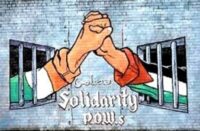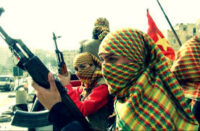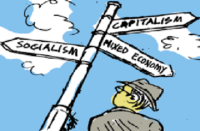1800s British colonialism’s “hierarchy of races” saw white Europeans as superior peoples, followed by east Asians, with the Irish tied with Africans, coming just ahead of the Australian aborigines, who placed bottom of the ladder. This grotesque “race science” would be taken up and furthered by the Nazis later on, a point that empire apologists who celebrate the likes of Churchill ignore.
This British view of the Irish, along with the need for Irish food and timber, explains the genocide of 1841-45, when one million Irish starved to death as food was exported to feed the British industrial revolution. Two million more fled as refugees – not as economic migrants – to Britain, the US, Canada and Australia, where they faced nativist opposition and discrimination: something ignored by the pro-imperialist Irish far-right today.
An Gorta Mór is not just historic. Even today, higher levels of mental illness, addiction and so on in Irish people are similar to other colonised peoples such as Native Americans, Maori, Aborigines, along with studies showing a higher rate of genetic disorders, schizophrenia and cardiovascular disease among the Irish diaspora. The genocide could not have happened if not for the forced displacement of Gaelic Irish during the English conquests: a lesson the Empire’s Zionist successors have learned from in Gaza.
Additionally, the genocide was not just mass murder and mass emigration, nor destruction of language and culture, but also saw the last remnants of the Gaelic social order dismantled, with starving tenants evicted by English landlords implementing a capitalist shock therapy, making profits from the nearly 4,000 food ships leaving Ireland in 1847 alone. Bear in mind that Britain had just paid 20 million pounds compensation to slave-owners after “abolishing” slavery in 1807, a result of slave revolts in Jamaica and Haiti.
Key British colonisers such as Humphrey Gilbert, Sir Walter Raleigh and Sir Francis Drake, got their start in colonisation in Ireland. Before he claimed Newfoundland for the British Crown, Humphrey Gilbert had, in Kilmallock, Co. Limerick, a “notorious pathway of skulls, lined with impaled Irish heads”. Francis Drake was involved in the Rathlin Island Massacre in Co. Antrim, with 600 dead Irish men, women and children.
The Empire also learned to employ native collaborators wherever possible, whether in the Royal Irish Constabulary or the East India Company’s native sepoys. When the Crown controlled India, it used what were called “martial races” to keep the colonised quiet; reflecting on the lessons they learned in Ireland, for example, in the 1601 Battle of Kinsale, 70% of the British forces were Irish. Not coincidentally, the same figure of 70% natives were in the British forces forces in the famous Battle at Plassey in 1757 which cemented British rule in India.
A Captain Thomas Lee’s practice in the 1570s of sending the skulls of killed Irish to British Queen Elizabeth was emulated after the British victory in Omdurman in Sudan in 1898. The British model of policing, with a community-based model in Britain itself, and a separate colonial, repressive police force in Ireland, was broadened out to keep natives in all continents down. Indeed, a special colonial police training school was established in Dublin’s Phoenix Park. Most notable were the former Black and Tans who, after their experience terrorising Ireland, were sent off to British-occupied Palestine.
As the British colonised Tasmania, they used prisoners from Ireland, including many women unable to speak English used as sex-slaves by the colonisers or housed in horrific prisons such as the Cascades Female Factory. Thousands of Irish women, called “Famine Brides” were forced to marry British colonisers in Australia. This followed on from the similar policies embraced by Oliver Cromwell in the Caribbean and the New World, with many Irish forced into indentured servitude.
While many today deny this as slavery, due to its twisting by American racists, the fact is that this practice was forced human trafficking of a subjugated people, with the victims of it enduring horrific lives and unable to return home. The practice of Irish who, facing the Penal Laws, massacre by Cromwell’s New Model Army and forced off their lands, only to be forcibly trafficked across the Atlantic to work for the same colonists, would meet the modern criteria of slavery, even if it conflicts with many American-centric liberal notions. Not for nothing did a Maori leader declare in 1879 that “I am an Irishman”.
We can also use examples of imperial atrocity in recent Irish history. For example, the revelation that British soldiers in Ireland in the ’70s used an Irish man’s skull as an ashtray. Or how British officers such as Frank Kitson used the experience they learned in the likes of Kenya, Malaya or the Aden in the colonial environment that saw the Bloody Sunday and Ballymurphy Massacres, the Dublin-Monaghan bombings, or the revelation in a recent documentary that British intelligence wanted loyalists to shoot-up a school.





